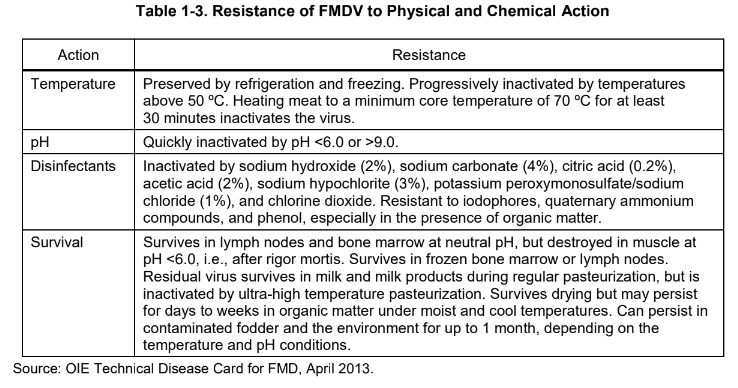



Foot-and-mouth disease SOPs: Environmental persistence of FMDV
Learn more about the the stability of foot-and-mouth disease virus (FMDV)Editor's note: The following content is an excerpt from Foreign Animal Disease Preparedness and Response Plan (FAD PReP): Foot-and-Mouth Disease Standard Operating Procedures: Overview of Etiology and Ecology which is designed to provide operational guidance for responding to an animal health emergency in the US.
Environmental persistence of FMDV
FMDV is moderately stable in the environment. The FMD virus is susceptible to both acid and alkaline pH. However, under certain conditions, it can maintain infectivity in the environment for extended periods of time. Presence of organic matter increases its persistence.

Sunlight does not have a significant effect on FMDV infectivity. FMDV can be found in the bone marrow, lymph nodes, and certain organs of deceased animals for extended periods of time because the pH does not decline sufficiently after death.
Environmental persistence of FMDV in excretions and surroundings
Under certain environmental conditions, FMDV can survive for significant periods on organic material. Reported survival times of FMDV include up to 20 weeks on hay, 4 weeks in cow’s hair in temperate temperatures, 14 days in dry feces, 39 days in urine, 6 months in slurry (winter), and 28 days in soil (fall). FMDV has also been recovered from bovine semen, and can maintain virus titers if frozen at −50°C for up to 320 days.
Environmental persistence of FMDV in milk and dairy products
Raw milk and milk products have the potential to cause infection in animals if not properly treated. Even with a typical pasteurization process, milk and milk products can still be infective to naïve animals. Typical pasteurization processes do not activate FMDV.
In milk, experiments have demonstrated that FMDV
- Survived in skim milk after heating to 72°C for 2 minutes,
- Survived in whole milk after heating to 72°C for 5 minutes, and
- Survived in cream after heating to 93°C for 15 seconds.
Additionally, here are some examples of the experimental resistance of FMDV in cheese:
- Survived in Camembert cheese for 21 days at 2°C .
- Survived processing for Cheddar cheese prepared from heated milk (but 30 days of curing inactivated the virus).
- Survived processing and curing for Cheddar cheese prepared from unheated milk for 60 days.
FMDV can also survive in other products, such as butter and butter oil, for extended periods (at least 45 days with storage at 4°C). However, FMDV has not been detected in whey constituents after processing.
Environmental persistence of FMDV in meat and meat products
FMDV can maintain infectivity for months in chilled or frozen lymph nodes (beef), liver, and blood. FMDV was detected at 11 days in beef frozen after slaughter and at 4 months in frozen liver. In salted bacon, FMDV was detected at 190 days and in pork sausages at 56 days.
Environmental persistence of FMDV in wool and hides
FMDV can survive on many materials. FMDV has been identified in wool 5-days post-exposure but was not recovered at measureable amounts from wool stored at 37°C after 40–96 hours, or wool stored at 18°C after 10–14 days, based on the strain. In hides, FMDV has been detected for 32 days or longer, depending on the humidity and temperature of drying and storage. For example, hides salted and stored at 4°C still had detectable FMDV at 352 days; hides dried at 20°C, 40 percent relative humidity had detectable FMDV at 42 days.


